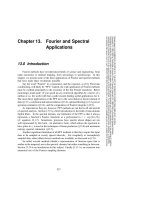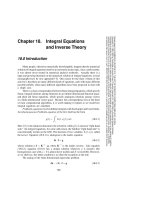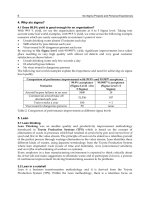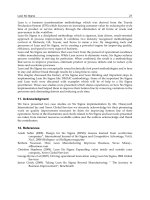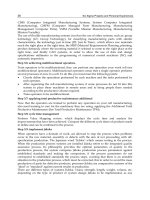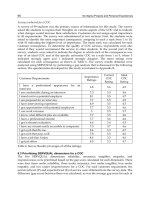Six Sigma Projects and Personal Experiences Part 1 ppt
Bạn đang xem bản rút gọn của tài liệu. Xem và tải ngay bản đầy đủ của tài liệu tại đây (638.69 KB, 15 trang )
SIX SIGMA PROJECTS AND
PERSONAL EXPERIENCES
Edited by Abdurrahman Coskun,
Tamer C. İnal and Mustafa Serteser
Six Sigma Projects and Personal Experiences
Edited by Abdurrahman Coskun, Tamer C. İnal and Mustafa Serteser
Published by InTech
Janeza Trdine 9, 51000 Rijeka, Croatia
Copyright © 2011 InTech
All chapters are Open Access articles distributed under the Creative Commons
Non Commercial Share Alike Attribution 3.0 license, which permits to copy,
distribute, transmit, and adapt the work in any medium, so long as the original
work is properly cited. After this work has been published by InTech, authors
have the right to republish it, in whole or part, in any publication of which they
are the author, and to make other personal use of the work. Any republication,
referencing or personal use of the work must explicitly identify the original source.
Statements and opinions expressed in the chapters are these of the individual contributors
and not necessarily those of the editors or publisher. No responsibility is accepted
for the accuracy of information contained in the published articles. The publisher
assumes no responsibility for any damage or injury to persons or property arising out
of the use of any materials, instructions, methods or ideas contained in the book.
Publishing Process Manager Iva Lipovic
Technical Editor Teodora Smiljanic
Cover Designer Jan Hyrat
Image Copyright 2011. Used under license from Shutterstock.com
First published June, 2011
Printed in Croatia
A free online edition of this book is available at www.intechopen.com
Additional hard copies can be obtained from
Six Sigma Projects and Personal Experiences, Edited by Abdurrahman Coskun,
Tamer C. İnal and Mustafa Serteser
p. cm.
ISBN 978-953-307-370-5
free online editions of InTech
Books and Journals can be found at
www.intechopen.com
Contents
Preface VII
Chapter 1 Lean Six Sigma 1
Vivekananthamoorthy N and Sankar S
Chapter 2 Definition of the Guide for Implementation Lean 23
Adan Valles-Chavez and Jaime Sanchez
Chapter 3 Quality Function Deployment
in Continuous Improvement 45
Elizabeth A. Cudney and Cassandra C. Elrod
Chapter 4 Analysing Portfolios of
LeanSix Sigma Projects 79
Theodore T. Allen, James E. Brady
and Jason Schenk
Chapter 5 Successful Projects from
the Application of Six Sigma Methodology 91
Jaime Sanchez and Adan Valles-Chavez
Chapter 6 Applying Six Sigma Concepts, Techniquesand
Method for Service Management: Business
and IT Service Management (BSM & ITSM) 117
Rajesh Radhakrishnan
Chapter 7 Demystifying Six Sigma Metrics in Software 127
Ajit Ashok Shenvi
Chapter 8 Gage Repeatability and Reproducibility
Methodologies Suitable for Complex
Test Systems in Semi-Conductor Manufacturing 153
Sandra Healy and Michael Wallace
Chapter 9 Adapting Lean Processes for
the Hospital/Surgical Environment 171
Jaideep J Pandit and Meghana Pandit
Preface
After the World War II, in response to “customer satisfaction”, many of the quality
improvement tools that we still use extensively today such as control charts, process
capability, and value analysis were developed and widely used in a wide range of
organizations from industry to health sector. Then, more recently, quality circles and
total quality management have shown the power of team-based process improvement.
ISO 9000 was developed as a standard for organization’s quality systems. To be
certified, organizations needed to document their quality system; they improved it
with reviews and audits. The identification of non-conformances and “corrective
action system” to prevent reoccurrences have taken their place in an organization’s
daily life. Finally today, we are talking about error-free processes, eliminating the
waste, and “do it right the first time”. Strategic approaches to achieve excellence now
is the main focus of Six Sigma and lean concept.
In fact, Lean and Six Sigma are two distinct management strategies; while Lean
methodology focuses on creating more value with less work, Six Sigma make ef-
forts to identify and eliminate defects in product development. Thus, Lean-Six
Sigma is a marriage of these two different strategies. They both contribute to an or-
ganization’s decision-making process by reducing inefficiencies as well as increas-
ing quality. They do not only cover defective products, but all types of defective
work, unnecessary processes, and services that don’t meet customer’s needs. There
is also a relationship of ISO to Six Sigma. While ISO is providing a standardization
among the quality improvement tools, Six Sigma presents a way to achieve error-
free processes.
Lean-Six Sigma provides principles and tools that can be applied to any kind of organ-
izations that is aiming to measure defects and/or error rates in order to reduce the cost
of products by eliminating the defects and waste.
In this book scientists from various regions of the world share their experiences and
knowledge about Lean and Six Sigma methodology. The chapters in the book cover
the basic principles of managing Lean and Six Sigma methodology in various disci-
plines of industry, business and even health sectors. We hope that this book will help
VIII Preface
employees worldwide at all levels in different organizations, who need to improve
their knowledge and experience in the field of Six Sigma and Lean concept.
Abdurrahman Coskun,
Tamer C. İnal
and Mustafa Serteser
Acibadem University, School of Medicine,
Department of Biochemistry Istanbul
Turkey
1
Lean Six Sigma
Vivekananthamoorthy N and Sankar S
KCG College of Technology,Chennai
India
1. Introduction
Due to increased globalization and constant technological advances and other competitive
pressures, the organizations have to accelerate the pace of change to adapt to new situations.
This climate introduces opportunities and threats and Organizations have to innovate and
strive for operational excellence. Six Sigma is the most popular quality and process
improvement methodology which strives for elimination of defects in the processes whose
origin is traced back to the pioneering and innovation work done at Motorola and its
adoption by many companies including GE, Ford, General Motors, Xerox etc. The primary
objective of Six Sigma is to reduce variations, in products and processes, to achieve quality
levels of less than 3.4 defects per million opportunities (DPMO). The important point to be
noted is reducing the defects involve measurements in terms of millions of opportunities
instead of thousands. Six Sigma is a culmination of several decades of quality improvement
efforts pursued by organizations world over due to pioneering work done by quality Gurus
Shewart, Deming, Juran, Crosby, Ishikawa, Taguchi and others. Dr. W. Edward Deming,
who is considered by many to be the “Father of modern Quality movement”, was
instrumental for transforming post war Japan into an economic giant because of helping for
systematic introduction of quality improvement measures by Japanese companies. Dr.
Deming had advocated popular quality improvement methods such as Total Quality
Management (TQM), Plan-Do-Check-Act methodology, 14 point rules and elimination of 7
deadly sins and he helped organizations to achieve operational excellence with much
customer focus. Later many US companies have gained much from Japanese experiences
and ideas on quality improvement concepts.
The Six Sigma concepts and tools used can be traced back to sound mathematical and
management principles of Gauss, Taylor, Gilberth and Ford for their contributions like
Sigma and Normal distribution (Gaussian distribution),Taylor’s Scientific Management,
Gilberth’s ‘Time and Motion study’ and Ford’s mass production of cars using ‘Assembly
line ‘ system.
Six Sigma when coupled with ‘Lean Principles’ is called ‘Lean Six Sigma’ which professes
eliminating waste in process steps by using ‘Lean Tools’ which is based on Toyota
Production System(TPS) which enhances value in Six Sigma implementation one step
further by increasing speed by identifying and removing non-value adding steps in a
process.
Execution of Lean Six Sigma project uses a structured method of approaching problem
solving normally described by acronym ‘DMAIC’ which stands for Define, Measure,
Analyze, Improve and Control.
Six Sigma Projects and Personal Experiences
2
Many organizations have achieved phenomenal success by implementing Lean Six Sigma.
Lean and Six Sigma are conceptually sound technically fool proof methodologies and is here
to stay and deliver break through results for a long time to come. Motorola had celebrated
20 years of Six Sigma in the year 2007 and as per Sue Reynard in an article in ISixSigma-
Magazine,” Motorola is a company of inventions and Six Sigma which was invented at
Motorola is a defect reduction methodology that aims for near perfection has changed the
manufacturing game of Motorola, but it didn’t stop there. As the Six Sigma has evolved
during the ensuing 20 years, it had been adopted worldwide and has transformed the way
business is done”.
This chapter focuses and highlights overview and details of some of the important aspects of
‘Lean Six Sigma’ and the tools used to implement it in organizations to improve their
bottom line by controlling variations in processes, reducing defects to near zero level and
adopting lean principles. The chapter is organized on the following broad topics: the history
of Six Sigma, the need for Six Sigma, Sigma Levels and motivation for Six Sigma, Lean
thinking, Lean Six Sigma, DMAIC methodology, Six Sigma and Lean tools, and case studies
on Lean Six Sigma implementations.
Six Sigma Tools are available as free open source templates which can be downloaded from
the URLs which are given in the references at end of the chapter.
2. What is six sigma ?
Six Sigma is a quality improvement methodology invented at Motorola in 1980s and is a
highly disciplined process improvement method that directs organizations to focus on
developing and delivering near perfect products and services. Six Sigma is a statistical term
that measures how far a given process deviates from perfection. The central idea behind Six
Sigma is, if we are able to measure how many “defects” that exist in a process, it can be
systematically figured out how to eliminate them and get close to “zero defects”.
In the year 1985, Bill Smith, a Motorola Engineer coined the term ‘Six Sigma’, and explained
that Six Sigma represents 3.4 defects per million opportunities is the optimum level to
balance quality and cost. It is a real-breakthrough in quality improvement process where
defects are measured against millions of opportunities instead of thousands which was the
basis those days.
Leading companies are applying this bottom-line enhancing strategy to every function in
their organizations. In the mid 1990s, Larry Bossidy of Allied Signal and Jack Welch of GE
Saw the potential in Six Sigma and applied it in their organizations which resulted in
significant cost savings in progressive years. GE reports stated that Six Sigma had delivered
$300 million to its bottom line in 1997, $750 million in 1998, and $2 billion in 1999.
2.1 History of six sigma
The immediate origin of Six Sigma can be traced to its eearly roots at Motorola ( Fig. 1), and
specifically to Bill Smith (1929 - 1993). Bill Smith was an employee of Motorola and a Vice
President and Quality Manager of Land based Mobile Product Sector, when he approached
then chairman and CEO Bob Galvin in 1986 with his theory of latent defect.
The core principle of the latent defect theory is that variation in manufacturing processes is
the main culprit for defects, and eliminating variation will help eliminate defects, which will
in turn eliminate the wastes associated with defects, saving money and increasing customer
satisfaction. Variation is measured in terms of sigma values or thresholds. The threshold
Lean Six Sigma
3
determined by Smith and agreed to by Motorola is 3.4 defects per million opportunities (3.4
DPMO), which is derived from sigma shifts from specifications.
Fig. 1. Bill Smith coins the term Six Sigma at Motorola.
Motorola adopted the concepts and went on to win the first ever Malcolm Baldrige Excellence
Award in 1988, just two years after Bill Smith’s introduction of Six Sigma.
3. Describing six sigma concept
Six Sigma is a method for improving quality by removing defects and their causes in
business process activities. The method concentrates on those outputs which are important
to customers and translates these customer needs into measurable requirements, the so
called CTQs (Critical To Quality). An indicator for the CTQs is identified and a robust
measurement system is established to obtain clean and precise data relating to the process.
Once this is in place, one can compare actual process behaviour to the customer-derived
specification and describe this in a statistical distribution (using mean, standard deviation
[σ] or other indicators, dependent on the type of distribution).
3.1 Inputs and output
The objective of the Six Sigma concept is to gain knowledge about the transfer function of
the process - the understanding of the relationship between the independent input variables
(Xs) and the dependent output variable (Y). If the process is modelled as a mathematical
equation, where Y is a function of X, i.e. Y = f(X1, X2, …,Xn), then the output variable (Y)
can be controlled by steering the input variables (Xs).
The Six Sigma drive for defect reduction, process improvement and customer satisfaction is
based on the “statistical thinking” paradigm:
All work occurs in a system of interconnected processes.
All processes have inherent variation.
Data analysis is used to understand the variation and to drive process improvement
decisions.
3.2 Variation
Six Sigma is all about reducing the variation of a process. The more standard deviations (σ) –
an indicator of the variation of the process – that fit between the mean of the distribution
and the specification limits (as imposed by the customer), the more capable is the process. A
Six Sigma process means that 6 standard deviations fit on each side of the mean, between
the mean and the specification limits. 6 Sigma equates in percentage terms to 99.9997%
accuracy or to 3.4 defects per million opportunities to make a defect. Fig 2 illustrates how
Six Sigma quality is achieved by reducing variations in a process.
Six Sigma Projects and Personal Experiences
4
Fig. 2. Reducing variation in a process using Six Sigma
3.3 Normal curve and sigma
Six Sigma concepts can be better understood and explained using mathematical term Sigma
and Normal Distribution. Sigma is a Greek symbol represented by "σ". The bell shape curve
shown in Fig. 3 is called "normal distribution" in statistical terms. In real life, a lot of
frequency distributions follow normal distribution, as in the case of delivery times in Pizza
Business. Natural variations cause such a distribution or deviation. One of the
characteristics of this distribution is that 68% of area (i.e. the data points) falls within the
area of -1σ and +1σ on either side of the mean. Similarly, 2σ on either side will cover
approximately 95.5% area. 3σ on either side from mean covers almost 99.7% area. A more
peaked curve (e.g. more and more deliveries were made on target) indicates lower variation
or more mature and capable process. Whereas a flatter bell curve indicates higher variation
or less mature or capable process. To summarize, the Sigma performance levels – 0ne to Six
Sigma are arrived at in the following way.
Fig. 3. Normal Distribution
If target is reached:
68% of the time, they are operating at +/- 1 Sigma
95.5% of the time, they are operating at +/-2 Sigma
99.73 % of the time are operating at +/-3 Sigma
Lean Six Sigma
5
Six Sigma: 3.4 ppm = 100-99.99966%
3.4 Six sigma and TQM
Six Sigma is not just a statistical approach to measure variance; it is a process and culture to
achieve excellence. Following its success, particularly in Japan, TQM seemed to be popular
in organizations which preached quality as fitness for purpose, striving for zero defects with
customer focus. Even though TQM was the management tool in the 1980s, by 1990s it was
regarded as failure and it was written off as a concept that promised much but failed to
deliver.
Research by Turner (1993) has shown that any quality initiative needs to be reinvented at
regular intervals to keep the enthusiasm level high. Against this background, Six Sigma
emerged to replace the ‘overworked’ TQM philosophy. The key success factors
differentiating Six Sigma from TQM are:
1. Six Sigma emphasizes on Statistical Science and measurement.
2. Six Sigma was implemented with structured training plans at different levels
(Champions, Master Belt, Black belt, and Green belt).
3. The project focussed approach with single set of Problem Solving Techniques (DMAIC).
4. The Six Sigma implementation effects are quantified in tangible savings (as opposed to
TQM where the benefits cannot be measured). Quantification of tangible savings is a
major selling point for Six Sigma.
3.5 Sigma quality level
Sigma Quality Level is a measure used to indicate how often the defects are likely to occur.
Sigma is a mathematical term and it is the key measure of variability. It emphasizes need to
control both the average and variability of a process. Table 1. shows different Sigma levels
and associated defects per million opportunities. For example, Sigma level 1 indicates that it
tolerates 690,000 defects per million opportunities with 31% yield. Sigma level 6 allows only
3.4 defects per million opportunities with 99.9997 yield.
Sigma Performance Levels - One to Six Sigma
Sigma Level Defects Per Million Opportunities
Percentage Yield
1 690,000 31
2 308,537 69
3 66,807 93.3
4 6,210 99.38
5 233 99.977
6 3.4 99.99966
Table 1. Sigma performance Levels
Before starting a Six Sigma Project,the important thing to be done first is to find the need for
Six Sigma.
It is natural for Organizational processes to operate around 3 to 4 sigma level. In this section,
the defect levels for some example scenarios one operating at 3 to 4 sigma level and other
operating at Six Sigma level are compared. The comparisons as per Table 2. show that the
defects at 3 to 4 Sigma level are found to be too high to be tolerated and organizations have
to strive to achieve Six Sigma level as an obvious move. This section elaborates the need for
Six Sigma with examples.
